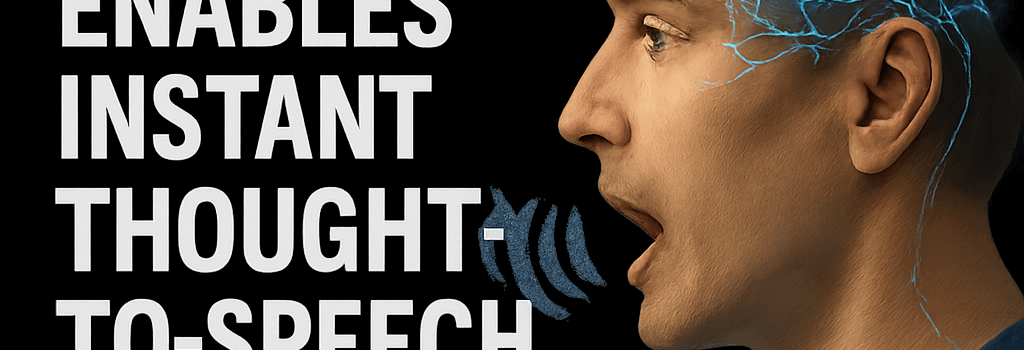Neural Prosthesis Enables Instant Thought-to-Speech Conversion

Introduction
Recent advances in brain-computer interfaces (BCIs) are edging us closer to a fully digital vocal tract. A new study from the University of California, Davis (UC Davis) demonstrates a neural prosthesis capable of translating intracortical signals directly into phonemes and prosody with end-to-end latency as low as 10 milliseconds. Unlike previous systems that decoded text, this approach synthesizes speech in real time, allowing users to modulate intonation, pitch, and rhythm freely.
From Text to Sound: A Paradigm Shift
Early BCIs for people with amyotrophic lateral sclerosis (ALS) and other disorders focused on text entry. Stephen Hawking’s cheek-muscle sensor enabled roughly one word per minute via character selection, synthesized by a DECtalk TC01 vocoder. More recent systems, including Stanford’s brain-to-text decoder led by Francis R. Willett, achieved ~75% word accuracy at several seconds of latency, later improved to 97.5% accuracy by Sergey Stavisky’s UC Davis group in 2024. However, these remained limited by predefined vocabularies (~1,300 words) and added speech-synthesis delays.
System Architecture and Technical Specifications
- Implant and Recording Hardware
- 256-channel Utah microelectrode array (Blackrock Microsystems) implanted in the ventral precentral gyrus.
- Sampling rate of 30 kHz per channel; bandpass filtered (300 Hz–6 kHz) to isolate action potentials.
- Spike sorting performed on‐chip via a custom FPGA module, reducing data throughput by 90%.
- Neural Decoder
- Deep recurrent neural network (bi-directional LSTM layers with attention) trained on >50,000 spoken syllables from able-bodied reference speakers.
- Real-time feature extraction: pitch (F0), formant frequencies (F1–F3), voicing probability, and spectral envelope coefficients.
- Continuous adaptation via Kalman filtering to compensate for electrode drift and nonstationary neural patterns.
- Vocoder and Synthesis
- Modified WaveNet vocoder fine-tuned on the patient’s pre-paralysis voiceprint (sampling rate 24 kHz, 16-bit depth).
- Latency budget: 5 ms for decoding, 3 ms for synthesis, 2 ms for I/O buffering.
Clinical Trial and Results
The study’s single participant, codenamed T15, is a 46-year-old male with advanced ALS. After implantation, T15 underwent three months of calibration sessions. During closed-vocabulary tests (6 choices), automated scoring reached 100% intelligibility. In open-vocabulary transcription by naïve listeners, the system yielded a word error rate (WER) of 43.8%, compared to 96.4% WER for T15’s unaided speech.
Expert Perspectives
“Achieving sub-10 ms latency is unprecedented in intracortical speech BCIs,” says Maitreyee Wairagkar, neuroprosthetics lead at UC Davis. “Real-time prosody control opens doors to natural, expressive communication.”
“Scaling to 1,600–2,000 electrodes, as companies like Paradromics are doing, could halve error rates,” notes Sergey Stavisky, senior author. “The hardware roadmap is aligned with emerging high-density arrays.”
Deep Analysis
1. Algorithmic Innovations
By leveraging attention-based LSTMs and continuous Kalman adaptation, the decoder learns temporal dependencies across phonemic units. Future iterations may adopt transformer architectures with sparsity constraints to further reduce computation time on implantable ASICs.
2. Integration and Power Constraints
Maintaining wireless operation requires <10 mW total power. UC Davis is exploring ultra–low-power mixed-signal ASICs for on-chip spike processing, aiming to eliminate percutaneous tethers and reduce infection risk.
3. Ethical and Regulatory Considerations
As speech BCIs approach real-world readiness, the FDA has issued draft guidance on neural device cybersecurity and data privacy. Researchers must navigate informed consent complexities, ensuring user autonomy over synthesized vocal identity and neural data streams.
Future Directions
- Scaling electrode counts to >1,000 channels for higher spatial resolution.
- Multi-modal integration with eye-tracking and EMG for hybrid control schemes.
- Closed-loop feedback incorporating real-time auditory monitoring to refine prosody.
- Commercialization pathways: Paradromics’ planned FDA IDE trials led by co-author David Brandman are slated for 2026.
Conclusion
This UC Davis neural speech prosthesis marks a significant leap toward restoring natural, expressive communication for paralyzed individuals. With ongoing hardware innovations and clinical efforts, fully digital vocal tracts may soon transition from lab prototypes to transformative medical devices.